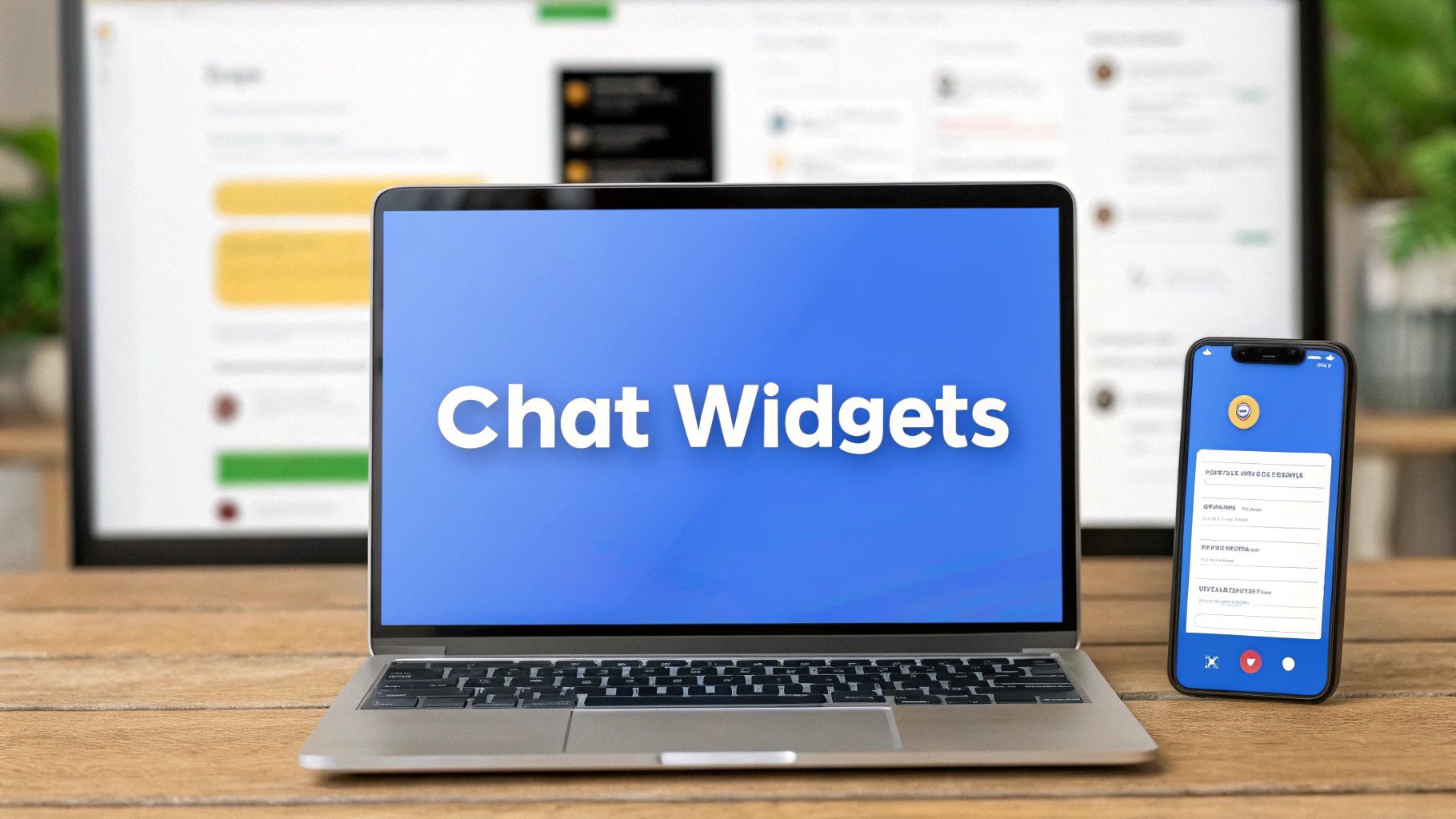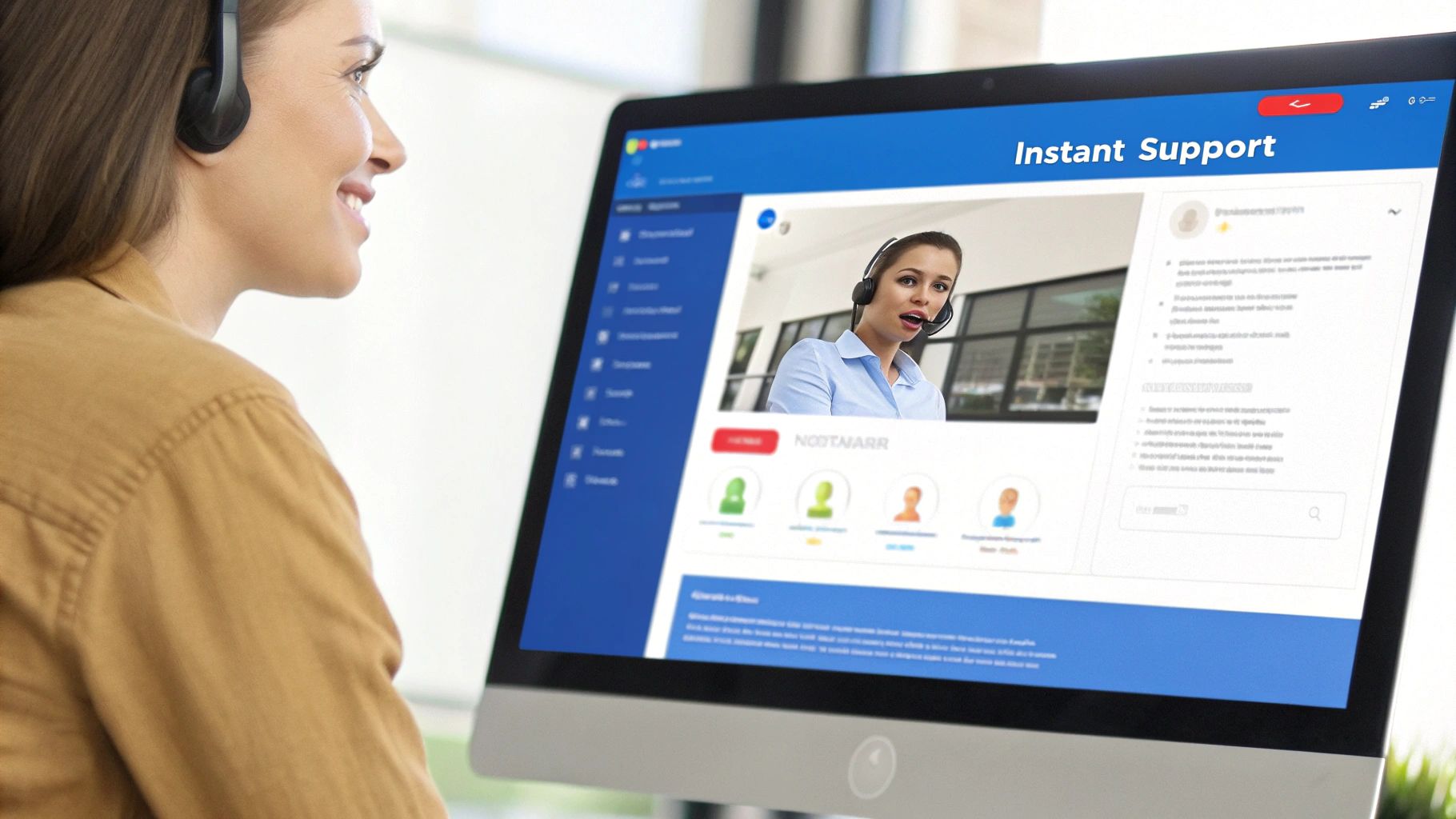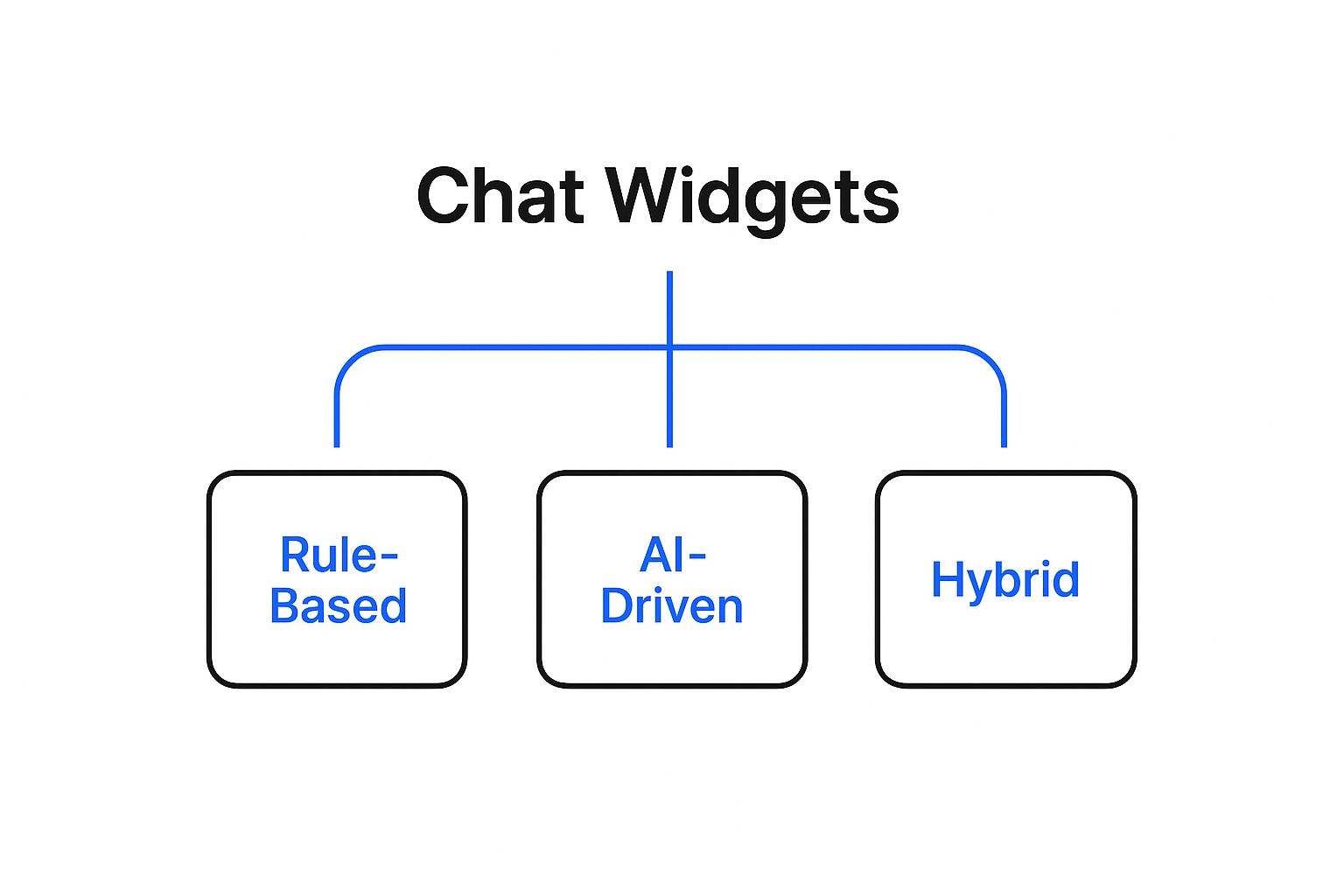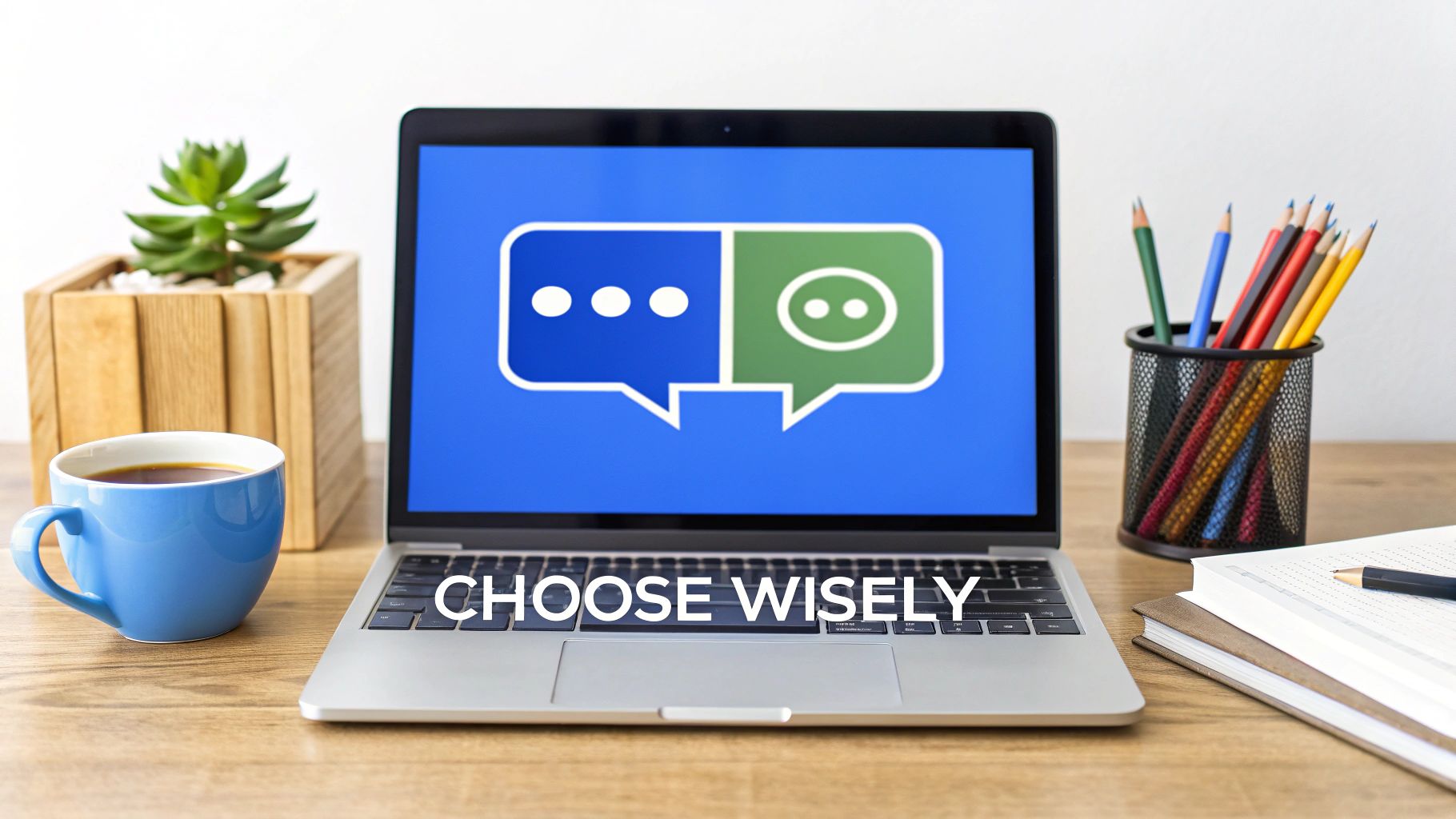
A Complete Guide to Chat Widgets for Websites
Discuss with AI
Get instant insights and ask questions about this topic with AI assistants.
💡 Pro tip: All options include context about this blog post. Feel free to modify the prompt to ask more specific questions!
Ever walked into a store and had a friendly employee greet you, asking if you need help finding anything? A chat widget is the digital version of that experience for your website—an ever-present, helpful assistant ready to engage visitors 24/7. It’s a direct line of communication that turns a passive scroll into a real conversation, building a connection right from the first click.
Think of a chat widget as your website's virtual front desk. It usually appears as a small, friendly icon in the corner of the screen, waiting patiently to assist. It's the starting point for instant communication, ready to answer questions, guide visitors to the right page, or offer a helping hand.
When someone lands on your site, the widget can pop up with a warm, automated welcome message. This isn't about being pushy; it's a gentle invitation to chat. Once a visitor engages, they're connected to either a live person from your team or an intelligent AI chatbot.
So, how does this little window actually work? It's surprisingly straightforward. A small snippet of code—typically JavaScript—is added to your website’s backend. This code is what tells your site to display the chat icon and launch the chat interface when a visitor clicks it.
Once that connection is made, the widget works in real-time. Messages fly back and forth instantly between the user and your business, whether it's a human agent or a bot on the other end. This immediacy is what makes it such a game-changer.
A chat widget fundamentally shifts the user experience from passive browsing to active engagement. It sends a clear message to every visitor: "We're here and ready to help." This simple promise can turn a moment of potential frustration into a positive, supportive interaction.
Today’s chat widgets are far more than just a place to type messages. They've evolved into sophisticated tools designed to improve the customer journey from start to finish.
- Live Chat with Human Agents: Nothing beats a real human touch for solving complex problems or closing a big sale. Live chat allows for those nuanced, empathetic conversations that build real trust.
- AI-Powered Chatbots: These automated helpers can field common questions around the clock, pre-qualify leads by asking a few key questions, and collect visitor details, freeing up your team to focus on more complex issues.
- Proactive Engagement: Modern widgets can be smart. You can set them up to automatically start a conversation based on what a visitor is doing, like how long they’ve been on the pricing page or if they have an item sitting in their cart.
By blending these capabilities, chat widgets for websites create a powerful and seamless channel for both sales and support. They give you the tools to offer immediate, personal help, which is often the key to turning a casual browser into a loyal customer.

Adding a chat widget to your website is far more than just a modern touch. It's a strategic move that delivers real, measurable results. Think of it as opening a direct, instant-access hotline to your customers, right when they're thinking about your brand. This simple tool can have a huge effect on their buying decisions and how they feel about your business as a whole.
When a potential customer has a question, they want an answer immediately, not hours later in an email. A chat widget removes that waiting period, clearing up friction and doubt that can kill a sale. It’s that real-time assistance that becomes a powerful driver for your business.
The data backs this up. Research shows a clear line between offering live chat and making more money. A stunning 63% of customers are more likely to buy from websites that offer chat widgets for websites. That small icon in the corner can be the very thing that turns a hesitant browser into a confident buyer by solving their problem on the spot. You can dig into more stats on how chat influences buying habits over at LiveChat.com.
The most immediate impact you'll see from a chat widget is its power to boost conversions. We've all been there—on the fence about a purchase, unsure about a product feature, a shipping policy, or a pricing detail. A quick chat can provide the final piece of information needed to click "buy."
This isn't just about answering questions. It's about building confidence at the most critical moment in the customer journey. By offering help exactly when it’s needed, you stop people from leaving their carts to look for answers somewhere else—most likely on a competitor's site.
Beyond that first sale, the sheer convenience of a chat widget helps build lasting relationships. People remember positive, effortless experiences. When customers know they can get quick support without wrestling with a phone menu or waiting on an email, they feel seen and valued.
That good feeling translates directly into loyalty. In fact, a solid 60% of customers say they are more likely to come back to a website that has live chat. This repeat business is the bedrock of steady growth, turning one-time buyers into genuine brand fans.
Chat widgets do more than solve problems—they create positive emotional connections. Every quick, helpful interaction reinforces the idea that your business is accessible, responsive, and trustworthy, which is the foundation of customer loyalty.
The benefits don't stop with the customer. A chat widget can also streamline your internal operations, making your support team much more efficient.
Here's how:
- Reduced Support Load: A single chat agent can often manage multiple conversations at once, something that’s simply not possible over the phone. This takes a huge amount of pressure off your support staff.
- Lower Costs: By handling questions that would otherwise come through more expensive channels like phone calls, you bring down your overall cost for each customer interaction.
- Focused Human Effort: Tools like Spur can automate the answers to frequently asked questions. This frees up your human agents to focus on the complex, high-value problems that truly need a personal touch. To learn more about this approach, check out our guide on customer service automation.
Ultimately, putting one of the best chat widgets for websites in place creates a win-win. Your customers get faster, better service, and your business operates more smoothly and cost-effectively.
Picking the right chat widget for your website can feel a little overwhelming. At first glance, most options look pretty similar, but the reality is there’s a world of difference between a basic chat box and a truly powerful business tool. The secret is to look past the shiny features and zero in on what will actually help you hit your goals, whether that’s driving more sales, delighting your customers with great support, or filling your pipeline with quality leads.
It's important to understand that not all chat widgets for websites are built the same way. Some are just simple tools for reactive, one-on-one conversations. Others are packed with sophisticated automation and intelligence that can transform how you do business. Getting this distinction right is the first step to making a choice you won't regret later.
A basic chat widget lets you talk to visitors in real time. That's a solid starting point, for sure. But a modern tool, like Spur, goes so much further. Think of it less like a simple chat window and more like an automated team member that’s on the clock for you 24/7.
It’s these advanced capabilities that turn a simple communication channel into a real growth engine.
- AI-Powered Automation: Instead of needing a person to handle every single inquiry, an AI chatbot can field all the common questions. This frees up your team for more complex issues and can even ask qualifying questions to separate the hot leads from the window shoppers before ever looping in a sales rep.
- Proactive Chat Triggers: Why wait for a visitor to reach out? Advanced widgets can intelligently engage people based on their behavior. For example, it can pop up with a helpful message if someone is lingering on a pricing page or has an item sitting in their cart, often preventing a lost sale.
- Deep Integrations: The best chat tools don't operate in a silo; they connect seamlessly with the other software you use every day. When your chat widget integrates with your CRM, it can instantly pull up a customer's history or create a new lead profile on the fly.
This image really helps break down the different kinds of chat tools you'll find out there.

As you can see, while the simpler rule-based bots offer a degree of automation, it’s the AI-driven and hybrid models that deliver truly intelligent and flexible conversations that feel natural to your website visitors.
So, which one is right for you? The best widget is the one that aligns perfectly with what you’re trying to accomplish. A small personal blog might just need a simple way to answer a few questions from readers. But a growing e-commerce brand or a B2B company will see massive returns from a more robust platform that can scale with their business.
Here’s an easy way to think about it: A basic widget is like a friendly door greeter. An advanced widget is more like a full-service concierge who already knows your customers, anticipates what they need, and connects them to the right person or resource instantly.
To help you visualize the difference, let's break down how basic and advanced features stack up against each other.
The table below contrasts the standard functionality you'll find in most free or basic chat widgets with the powerful capabilities offered by more advanced, AI-driven platforms.
Feature Category Basic Functionality Advanced Functionality Lead Generation Collects name and email. Qualifies leads with custom questions and books meetings directly into a calendar. Support Answers simple, direct questions. Resolves complex issues with AI, with a seamless handoff to a human agent when needed. Engagement Reacts to user-initiated chats. Proactively starts conversations based on specific user behaviors (e.g., time on page, exit intent). Analytics Tracks chat volume and response times. Provides deep insights into user needs, conversation trends, and customer pain points.
As you can see, the gap is significant. Advanced tools don't just do more; they provide a completely different level of strategic value.
Ultimately, choosing the right chat widget is about looking at your long-term strategy. While a basic tool can solve an immediate problem, an advanced, AI-powered platform like Spur is a true investment in efficiency, better customer experiences, and scalable growth for years to come.

Here's a classic question in customer engagement: Should you wait for people to come to you, or should you make the first move?
Traditionally, most live chat is reactive. A customer has a question, they click the little chat icon, and an agent or bot responds. It works, but it puts all the pressure on the visitor to get the ball rolling.
Proactive chat completely flips that around. Instead of waiting, you start the conversation based on what the visitor is doing. Think of it like a sharp retail employee who sees you looking a little lost in an aisle and walks over to ask, "Finding everything okay?" When it's done right, it feels helpful and timely, not pushy.
The magic of proactive chat is all in the timing. Blasting a chat pop-up the second someone lands on your homepage is a surefire way to annoy them. The real goal is to offer help at the exact moment it’s needed most. That's where smart triggers come in.
These are simply rules you set up to launch the chat widget automatically based on visitor behavior.
Here are a few common and effective triggers:
- Time on Page: A visitor has been staring at your pricing page for over 60 seconds. A simple message like, "Have any questions about our plans?" can be the nudge they need.
- Cart Abandonment Risk: Someone adds a product to their cart but then hesitates before checking out. A well-timed message offering assistance or even a small discount can be just the thing to close the sale.
- Specific Page Visits: If a user is browsing your technical "integrations" page, they're likely a serious prospect. A targeted message asking if they need help connecting a specific tool shows you're paying attention.
The secret to great proactive chat is making it relevant. Your message needs to feel like a natural part of what the user is already doing—a solution to a problem they're probably thinking about right then. It turns a potential interruption into a genuine opportunity.
To really get the most out of your chat widget, it helps to understand and apply proven live chat best practices.
Proactive chat does more than just solve problems; it helps you create personalized experiences for every visitor. By tailoring your outreach to what users are doing on your site, you show them you understand their needs and are ready to help.
This kind of personalized, automated support builds a ton of trust and helps guide people toward their goals. For many businesses, it’s a key piece of a bigger picture. You can learn more about how to automate customer service to see how it all fits together.
Let's get practical. A chat widget is more than just a pop-up window; its real value shows up when you apply it to specific business challenges. The way an e-commerce store uses chat is worlds apart from how a B2B company might.
Think about it this way: an online shop wants to make a sale right now. A B2B firm, on the other hand, is playing the long game, building a relationship that could lead to a major contract down the road. A good chat tool can be molded to master both scenarios, adapting to what your customers need and what you want to achieve.
For any online store, a chat widget for your website is like having your best salesperson on the floor 24/7. It's there to offer a helping hand at the most crucial moments of a customer's shopping journey, which has a direct effect on both sales and how happy your customers are.
Here’s how that plays out in real-world situations:
- Personalized Product Recommendations: Imagine a customer is looking at hiking boots. They can pop open the chat and ask, "Which of these are best for cold, wet weather?" An agent (or a smart chatbot) can immediately point them to the perfect insulated, waterproof pair, closing the deal with expert advice.
- Real-time Order Tracking: The question "Where is my order?" is inevitable. Instead of forcing customers to dig through emails for a tracking link, the chat widget can pull up the live shipping status instantly. It’s a small thing that massively reduces customer anxiety.
- Seamless Checkout Assistance: A customer fumbling with a promo code or hitting a snag at the payment screen is a sale at risk. A proactive chat can pop up and ask if they need help, guiding them through the final step and rescuing the abandoned cart.
The results speak for themselves. Adding live chat can boost the average order value by a whopping 43% at checkout. What's more, 51% of consumers who engage with live chat are more likely to come back and shop again. Many businesses are also tapping into chat on messaging apps people already use every day. Our guide on WhatsApp for e-commerce dives into how that can extend your customer service reach.
In the B2B space, the sales cycle is much longer and the deals are bigger. Here, the chat widget transforms into a sharp, efficient tool for generating and qualifying leads. It works tirelessly to keep your sales pipeline full.
For a B2B company, a chat widget isn't just about answering questions. It's the first handshake—an intelligent system designed to identify high-potential prospects, book qualified meetings, and deliver premium support that retains key clients.
Check out these essential B2B applications:
- Instant Lead Capture: When a decision-maker lands on your pricing page, the widget can spring into action. A chatbot can ask a few smart, qualifying questions about their company size and needs, then capture their contact details right then and there.
- Automated Demo Scheduling: Forget clunky forms and back-and-forth emails. A prospect can book a demo with your sales team directly inside the chat window, picking a time that works for them from an integrated calendar. It’s frictionless.
- Premium Technical Support: For your existing clients, chat offers a direct line for immediate help with technical issues. Resolving their problems quickly doesn't just fix the issue; it reinforces the value of your partnership.
Chat widgets are also fantastic for guiding prospects through the entire sales funnel. You can dig deeper into proven B2B lead nurturing strategies to see how integrated communication tools can help turn a curious visitor into a loyal customer.

The evolution of chat widgets for websites has hit a major turning point, and it’s all thanks to artificial intelligence. Today’s AI chatbots are a far cry from the clunky, script-based bots you might remember. Instead of just spitting out pre-programmed answers, they’ve become sophisticated tools that can actually understand what a visitor wants.
It’s best to think of them less like auto-responders and more like intelligent conversational assistants. These AI systems can figure out a user's intent, handle complex questions with multiple parts, and provide personalized interactions on a huge scale. This massive leap in capability is exactly why businesses of all stripes are bringing them on board.
The numbers really drive this home. Since 2019, the use of chatbots on websites has shot up by a staggering 92%, making it the fastest-growing communication channel for brands. This isn't a niche trend, either—58% of B2B companies and 42% of B2C companies are now using them.
What's behind this massive growth? The ability to provide immediate, genuinely helpful support. Modern AI chatbots have moved way beyond answering "What are your business hours?". They can now tackle a whole range of tasks that used to require a person.
Here’s a quick look at what makes them so powerful:
- Instant Problem Solving: AI can instantly scan a knowledge base to give detailed answers to technical questions or walk users through troubleshooting steps.
- Personalized Experiences: By connecting to your other business systems, an AI bot can pull up a customer's order history, check their account balance, or even suggest products based on past purchases.
- Seamless Agent Handoff: When a conversation gets too complex for the AI, it can gather all the important details and pass the chat to a human agent, who has all the context they need to jump right in.
Today’s AI chat isn't about replacing people; it’s about making them better at their jobs. It takes care of the routine, repetitive questions so your team can focus on the high-value conversations that build real relationships and drive growth.
Beyond just chatting, AI is playing a huge role in fine-tuning business processes and improving efficiency, as seen in examples of AI-powered automation in operations. By taking on these jobs, AI makes your website communication smarter, faster, and a whole lot more effective.
Whenever you're thinking about adding a new tool to your business stack, questions are bound to come up. Adding a chat widget for your website is a big move, so let's walk through some of the most common concerns. My goal is to help you feel confident about taking the next step.
This is probably the number one question I hear, and for good reason. Site speed is everything for user experience and SEO.
The good news is that any well-made, reputable chat widget is built to be incredibly lightweight. They use a smart technique called asynchronous loading. Think of it this way: your website content loads first, and the chat widget loads in the background, on a separate track. This clever approach means it won't slow down your site's initial load time or hurt important performance scores like Core Web Vitals.
Just be sure to pick a trusted provider known for clean, optimized code. That's the key to a smooth experience for everyone.
The price tag on a chat widget can swing pretty widely, and it all comes down to what you need it to do.
Many providers, Spur included, offer free plans that are genuinely useful. These are perfect for small businesses or anyone just dipping their toes in the water, usually giving you live chat basics and some simple branding options.
If you need more firepower, paid plans typically run anywhere from $20 to over $100 per agent per month. Stepping up to a paid tier is what unlocks the really powerful tools, like AI-powered chatbots, seamless integrations with your CRM, and in-depth analytics. It's all about matching the features to your business goals.
The best way to think about it isn't as a cost, but as an investment. The right widget pays for itself by boosting sales, making customers happier, and helping your team work smarter.
Not always! The size of the team you'll need is tied directly to your website traffic and what you're trying to achieve.
For a website with lower traffic, a single person can often manage incoming chats right alongside their other duties. Mobile app notifications make it easy to stay on top of new messages without being chained to a desk.
If you have a high-traffic site, you'll definitely want at least one dedicated agent or even a small team to keep up. But here's the game-changer: an AI chatbot. It can be your first line of defense, handling routine questions and initial contacts 24/7. This frees up your human agents to focus on the complex, high-value conversations, making chat a totally scalable solution for any size business.
Ready to see how an AI-powered chat widget can change the way you talk to customers and grow your business? With Spur, you can automate your support, capture more leads, and keep customers engaged around the clock. Start your free 7-day trial today and get it running in minutes. Learn more at spurnow.com.
